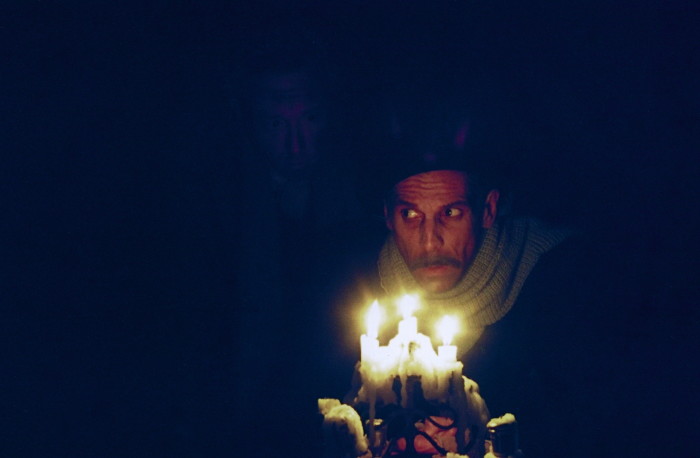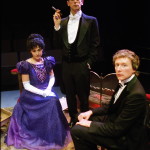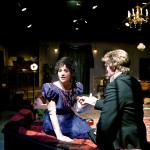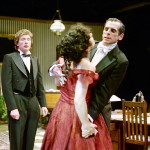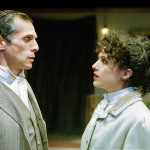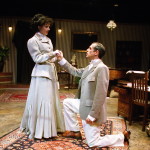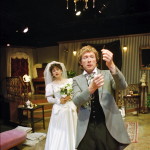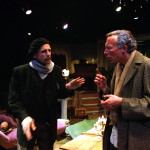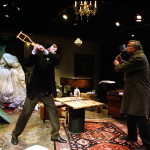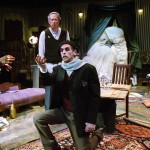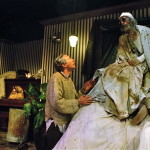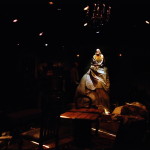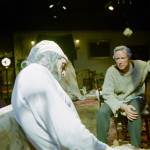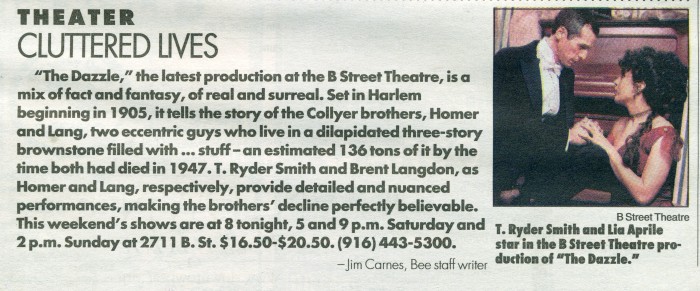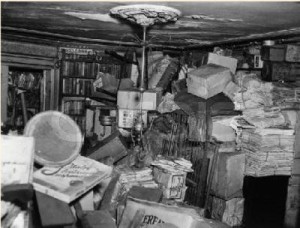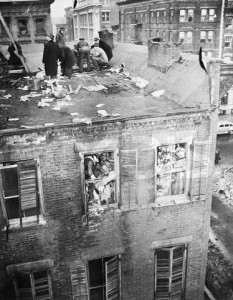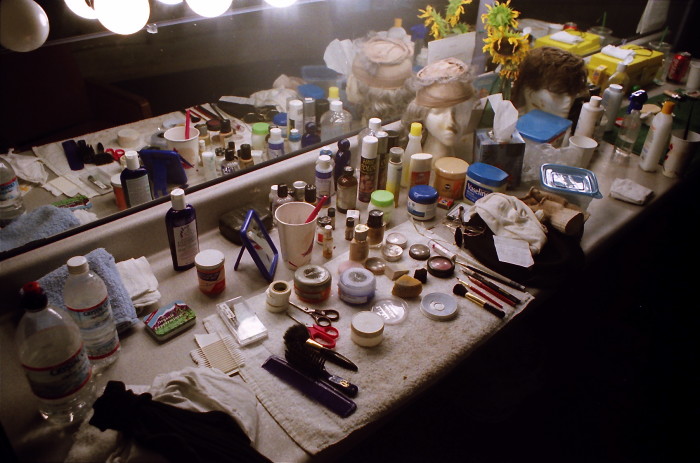Above: Lia Aprile, Brent Langdon, T. Ryder Smith.
Photos by T. Ryder Smith
Excerpts from the reviews
Full reviews are below
“It’s a mix – a swirl, really – of fact and fantasy, of real and surreal, that , like a dream, seems not to make sense until you let it explain itself to you, and even then . . . Some stuff happens, a lot of stuff is collected, and nobody lives happily ever after. . . . T. Ryder Smith and Brent Langdon, who play Homer and Lang, respectively, provide detailed and nuanced performances, making the brother’s decline perfectly believable. . . . The play’s mix of tenderness, humor, and tragedy is rewarding.” Jim Carnes, Sacramento Bee
“What makes it so fascinating is that the brothers don’t really have one major struggle—it’s more a gradual slide that happens slowly, so slowly that you can see how the two siblings went from society eccentrics to social recluses in their lifetimes. . . . The strangeness of the play stretches out to the structure as well, one that is rather schizophrenic in itself, traveling from comedy to drama to tragedy, and finally to surrealism. The first half is the most successful, with beautiful lyrical passages and elegant language that’s mesmerizing, and scenes that are all at once painful, poetic and pathetic. . . . ultimately what we get is a memorable and haunting play that speaks to the heart, about the heart, and the mysteries of the mind. . . . Both Langdon and Smith capture the tortured spirits of men possessed by both talent and psychosis and leave an indelible mark on the audience.” Patti Roberts, Sacramento News & Review
Publicity
Footnote
Above: the home of the real-life Collyer brothers, the models for the play. Their brownstone was cleared out after the brothers’ dead bodies were dicovered in it. Fireman still refer to houses packed with garbage and hoarded goods “a Collyer house”. Below: Homer Collyer, going through the “front entrance”.
Offstage
Full reviews
Sacramento Bee, Jim Carnes – Harlem hermits ‘Dazzle’ the mind in dreamy drama. Playwright Richard Greenberg should watch what he eats. He appears to have gotten into a stew like one cooked up by one of his characters – one that includes the ingredients library paste and cinnamon, and it’s the latter that the wrong spice. An upset tummy seems to have given him a crazy dream. How else to explain ‘The Dazzle’, a new play that opened on Sunday at the B Street Theatre? It’s a mix – a swirl, really – of fact and fantasy, of real and surreal, that , like a dream, seems not to make sense until you let it explain itself to you, and even then . . . ‘The Dazzle’ is set in Harlem beginning in 1905, and tells the story – part of the story – of the Collyer brothers, Homer and Langley. The Collyers really existed, and they really were two eccentric dudes who lived in a dilapidated three-story brownstone at 2078 Fifth Avenue, to be exact. They were – well, Langley was a pack rat. He collected stuff just because it was stuff, an estimated 136 tons of it by the time the two brothers died in 1947. Homer allowed the collecting, even encouraged it in a way because his own eccentricity – his obsession – was the story: he wanted something to happen. The play attempts to explain how things got the way they did for ‘the hermits of Harlem’. The condensed version of the play’s plot is something like this: Two brothers live in the home inherited from their parents. Langley, or Lang, the younger, has some musical talent but is too dysfunctional to make a career of it. Homer leaves his career as an admiralty lawyer to take care of his brother’s business. Langley is obsessed with things. He’s fascinated by their very ‘thingness’. To him, ‘Everything that is, is fine.’ His brother, not wanting to lose what’s left of the family finances, says ‘I am my brother’s . . . accountant.’ Enter a woman who would marry one of the brothers but is jilted, only to come back some years later for the other, but that’s not to be, either. Some stuff happens, a lot of stuff is collected, and nobody lives happily ever after. Greenberg’s play is afscinating in fits and starts, but like that dream, it has elemets that just don’t seem to fit. Foremast is the woman, Milly, luminously portrayed by Lia Aprile. Milly is one of those extraneous ‘dream’ details that seem to serve to confuse more than elucidate, and she’s totally superfluous to the story of the crazy Collyer brothers. T. Ryder Smith and Brent Langdon, who play Homer and Lang, respectively, provide detailed and nuanced performances, making the brother’s decline perfectly believable. Smith’s Homer is at first rigid and direct, as a lawyer-accountant would be, but he softens as his exposure to Lang’s world gradually gets to him. he bends to his brother’s will, even physically. Langdon’s Lang is a full-out romp from the beginning. Turned on by sight and sound and small, he is excited by the world – excited to the point of being overwhelmed. Langdon’s eyes are lighted by the fire of his character, and he gathers attention to himself in the same way Lang gathers stuff. You can’t not watch him. In a play such as this, the set is almsot as important as the characters, and Ed Duffy’s set construction and Rick Ortenblad’s senic design are top-notch. Ortenblad creates a stage that is almost refined at first but suggests the clutter to come, and then crafts a glorious stageful of mess. William McNulty, from the Actors Theatre of Louisville, directs the three-person cast, moving it – sometimes literally – through the hazards of Greenberg’s story and setting. Dawn Sullivan’s costume designs are fitting – her dresses for Milly are beautiful creations – and Ron Dumonschelle’s lighting is especially effective in creating the dim-cave look as the collection of junk increases and the brother’s situation declines. There is one lovely scene in which candlelight is augmented so subtly is almost imperceptible. ‘The Dazzle’ is a very wordy play, and at nearly 2 1/2 hours, including intermission, it s not a minor investment of time and attention. But its mix of tenderness, humor, and tragedy is rewarding. And it may just send you home to clean out a closet or two. You wouldn’t want to be haunted by the hermits of Harlem. 7.30.02
Sacramento News & Review, Patti Roberts – Society’s Hermits. A play that takes place in 1905 complete with Victorian costumes and a turn-of-the-century parlor set, produced by the B Street Theatre? Just what the heck’s going on here? The theater renowned for its urbane and contemporary plays is actually presenting one of its first-ever period pieces, though in keeping with B Street’s penchant for quirky endeavors, their newest production’s still in the realm of peculiar and definitely out of the mainstream. The Dazzle is an absorbing look at people who intrigue us when we read about them—hermits secluded in trash-packed houses, bodies found amid canyons of junk. Playwright Richard Greenberg takes that fascination and fashions it into a play that examines two brothers who struggle with their diminishing reality. Actually, what makes it so fascinating is that the brothers don’t really have one major struggle—it’s more a gradual slide that happens slowly, so slowly that you can see how the two siblings went from society eccentrics to social recluses in their lifetimes. The play’s concept is based on a true account, though the details and the beautifully written script are crafted by Greenberg. Langley and Homer Collyer were raised in their stately Harlem mansion by society parents in the late 1800s, but were found dead inside the dilapidated and debris-dense mansion years later, secluded inside walls of bundled newspapers and accumulated junk. The Dazzle takes us on the intriguing journey that Greenberg imagines the siblings took, the one that starts with Homer (T. Ryder Smith) taking to heart his mother’s decree to look after younger brother Lang (Brent Langdon). Lang, the concert pianist whose endearing scatological reasoning and obsessive-compulsive behavior is veering out of control, confounds and confines Homer, who’s own eccentricities begin to unravel. “My brother makes an epic of a molecule,” says Homer of Lang, who takes an hour to play the minute waltz, and will stare at a vase all day long. “What would he do with the world?” Homer almost finds out when a society woman Millie (Lia Apirle) decides she wants to marry Lang, mostly to shock her upper-crust family. The strangeness of the play stretches out to the structure as well, one that is rather schizophrenic in itself, traveling from comedy to drama to tragedy, and finally to surrealism. The first half is the most successful, with beautiful lyrical passages and elegant language that’s mesmerizing, and scenes that are all at once painful, poetic and pathetic. Lang’s descriptions of watching men return home from work is as beautiful as watching American Beauty’s swirling paper trash scene. The second half, while still captivating, slips a bit with the unnecessary return of Millie, whose characterization doesn’t ring as true as the first half. And we’ve lost the strange beauty of madness, while being left with a more cluttered, out-of-focus version. But ultimately what we get is a memorable and haunting play that speaks to the heart, about the heart, and the mysteries of the mind. B Street Theatre’s ongoing relationship with the Actors Theatre of Louisville pays off here. Artistic and producing directors Timothy and Buck Busfield take yearly jaunts to the Actors Theatre’s Humana Festival of New American Plays looking for innovative material, and this time they’ve not only brought back the play, but also the very talented director William McNulty, as well as exceptional actors Langdon and Smith. Both Langdon and Smith capture the tortured spirits of men possessed by both talent and psychosis and leave an indelible mark on the audience. Apirle is wonderful in the first half, but through no fault of her own, is less effective in the underdeveloped character in the second half. 8.01.02
Newsreview.com, Patti Roberts – An absorbing look at people who intrigue us when we read about them–hermits secluded in trash-packed houses, bodies found amid canyons of junk. The play’s concept is based on a true account–Langley and Homer Collyer were raised in their stately Harlem mansion by society parents in the late 1800s, but were found dead inside the debris-dense mansion years later. The play’s first half is the most successful, with scenes that are all at once painful, poetic and pathetic. The second half, while still captivating, slips a bit when it loses the strange beauty of madness, while leaving a more cluttered, out-of-focus vision. But ultimately what we get is a memorable and haunting play that speaks to the heart, about the heart, and the mysteries of the mind.
[previous] [next]
